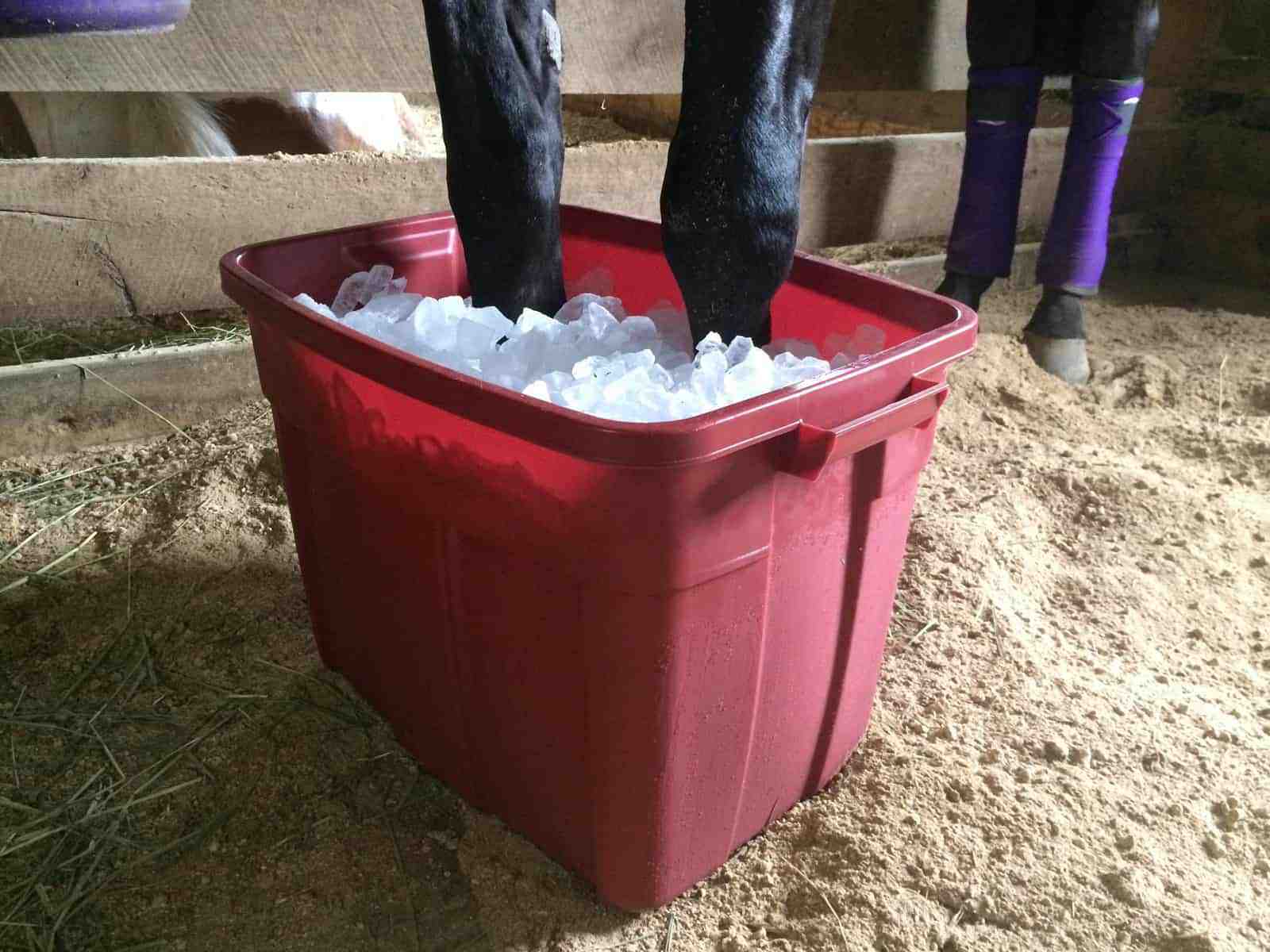Tips for Managing Acute Laminitis

At the 2015 World Equine Veterinary Association Congress, held Oct. 8-10 in Guadalajara, Mexico, Steve O’Grady, DVM, MRCVS, reviewed how to handle cases of acute laminitis. O’Grady is a veterinarian, farrier, and the owner of Virginia Therapeutic Farriery, in Keswick.
O’Grady said laminitis follows a sequence of stages:
- The developmental stage, when the internal damage to the lamellae occurs and which ends with the onset of clinical signs (such as pain, an increased digital pulse, and a laminitic stance);
- The acute stage, which generally affords the horse’s caretakers a small window—24 to 72 hours or until the coffin bone begins to displace from its normal position in the hoof capsule—to intervene and reverse or halt the internal damage; and
- The chronic stage, which generally begins within 72 hours after the acute stage began and during which time the coffin bone continues to move within the hoof capsule and clinical signs continue.
Despite this relatively uniform series of events that takes place with each laminitis case, regardless of cause, it remains challenging to treat.
“There is no proven or consistent treatment for laminitis,” O’Grady said. “Consequently, treatment regimens for both acute and chronic laminitis generally remain empiric and are based on the past experience of the attending clinician.”
All treatments should, however, focus on controlling the horse’s pain and minimizing damage to the lamellae.
Evaluating and Managing Acute-Stage Horses
Treatment should begin as soon as possible in the acute phase to offer the horse the best chance of recovering. And before anything else, establish a treatment team that includes the horse’s owner or manager, a veterinarian, and a farrier.
“The equine practitioner is responsible for addressing the overall health and welfare of the horse,” O’Grady said. “When confronted with a serious case of laminitis, a farrier will also play a prominent role in treatment and, in most cases of severe chronic laminitis, the predominant long-term role. The team is completed with the owner or trainer of the animal, who will often be the primary caregiver, the party who makes decisions, and the one responsible for the financial obligations associated with the treatment.”
Especially during the acute stage, he stressed, communication between all three parties is key. Treatment plans and the horse’s status can change rapidly, so ensure open lines of communication when dealing with an acutely laminitic equid.
The veterinarian should make sure the owner understands the risks associated with severe, acute laminitis, he said. Horses with this type of disease generally don’t have a good prognosis and, as mentioned, there’s no proven treatment method. Therapy can be time-consuming, prolonged, and expensive, and the disease’s course is unpredictable. For example, if three horses are afflicted with the same type and degree of laminitis, one horse might consistently respond favorably, another might respond well but suddenly take a downward turn, while the final patient might show no response to any therapeutic options. Thus, the owner should also understand that it’s impossible to accurately predict a case’s outcome, O’Grady said.
There’s a substantial amount of information a veterinarian must ascertain when faced with an acutely laminitic horse, O’Grady said. “We know there’s pathology present, but what’s the extent of this damage?” he said. “Have we missed the window for resolution?”
Further, a thorough history can help the practitioner determine whether the laminitis likely developed due to systemic disease, carbohydrate overload, medications (such as corticosteroids), or whether it’s an idiopathic case. “Sometimes we just don’t know why they develop it,” he said.
Of course, a detailed physical and hoof exam is “mandatory” in acute laminitis cases, O’Grady said. He encouraged attendees to pay special attention to the horse’s stance, the degree of lameness, the intensity of the digital pulse, whether there’s heat in the horse’s hooves, the coronary bands (checking for depressions, which could indicate that the coffin bone is already displaced to some degree), and the hoof size and conformation. The vet should always use hoof testers to localize tender areas.
After a complete thorough exam, the veterinarian must develop a treatment plan. Remember, O’Grady told attendees, “there are no proven consistent treatments.” But he discussed several medical options:
- Non-steroidal anti-inflammatory drugs (NSAIDs) Veterinarians can use these medications to help keep the horse comfortable because they have both analgesic (pain-killing) and anti-inflammatory properties. He advised using NSAIDs at their label doses and avoiding administering more than one at a time. O’Grady stressed that NSAIDs should be used judiciously to help the horse “respect” his feet—if you provide too much, the horse might move around enough to cause additional damage; too small of a dose won’t reduce inflammation or pain levels enough to keep the horse comfortable.
- Vasodilators Theoretically, vasodilators (medications designed to increase blood flow, in this case to the hoof) could help ensure continued perfusion to the foot. However, O’Grady cautioned that most vasodilators have never been studied in the laminitic horse and, thus, their benefits or drawbacks are unknown.
- Dimethyl sulfoxide (DMSO) DMSO has anti-inflammatory properties, is a diuretic and an oxygen radical scavenger (one of the byproducts of inflammation), and could also aid in vasodilation, making it seem like a logical treatment option. But again, there’s currently no proof of its efficacy in treating laminitis-related pain, he said.
- Cryotherapy Submerging horses’ lower limbs and feet in an ice water slurry appears to be useful for preventing further damage to the lamellae, O’Grady said. He encouraged attendees to use a tub filled with ice and water and to submerge horses’ limbs up to their knees or hocks for the best chance of getting the desired effects.
O’Grady also described two imaging options that can prove useful for gaining information about what’s going on inside the horse’s hooves. He encouraged attendees to take baseline radiographs (X rays) to assess what structural damage might have occurred in the hoof capsule and to take subsequent serial X rays to monitor the progress as treatment continues. He stressed that practitioners should take a minimum of two views for each hoof—a lateral (from the side) and a dorsopalmar (from the front).
O’Grady also touched on the venogram, a procedure veterinarians use to visualize blood flow within the foot. He cautioned that venograms might not be beneficial in the acute stage, as the lamellae is edematous (fluid-filled) and won’t show the veterinarian how to alter treatment plans. He also said he does not like to administer nerve blocks to laminitic, which is required to perform a venogram. However, practitioners can often garner important diagnostic and prognostic information regarding the case from these images.
Farrier Intervention
On the farriery side, O’Grady said each horse should be treated individually using biomechanical principles to change the forces on the laminitic foot. These principles include redistributing the load on the foot, addressing breakover, and applying heel elevation, if necessary, he said.
If a horse in the acute stage is wearing shoes, he recommends removing them early in the disease course. This, he said, will transfer the horse’s weight from being borne mainly through the hoof wall and lamellae (as occurs with shoes, since the sole and frog do not touch the ground) to being borne by the hoof’s entire solar surface. The horse will be painful, he warned, so he encouraged attendees to remove each nail individually rather than pulling the shoe off normally.
Once the shoes are off, O’Grady suggested trimming the toe of the affected hooves in moderation from the outer surface to remove excessive length. Don’t take anything off the sole, he said. Rather, square and bevel the toe to improve breakover.
He also noted that deformable bedding, such as sand, can help acutely laminitic horses. Sand, he said, allows the horse to position his feet as desired—typically the horse will bury the toe in the sand with the heel raised. If an owner is resistant to bringing sand in, he said you can instead secure plastic bags of sand to the horse’s feet.
O’Grady also touched on the use of cushioned hoof boots for pain relief. There are mixed reviews regarding their usefulness, he noted, but they’re convenient for vets and owners alike.
As the horse moves from the acute to the chronic stage, the farrier can choose from several footwear options, O’Grady said.
Wooden shoes, he said, are useful for chronic cases, but can even be used in some acute cases. Wooden shoes are custom-made for each horse and are designed to provide an optimal healing environment for the hoof. The wooden shoes are simply screwed onto the hoof with impression material between the sole and the wood. O’Grady recommended using casting material around the perimeter of the hoof to provide extra support.
Farriers also have many hoof pads and packings at their disposal for managing laminitic horses. While anecdotal evidence and personal experiences might support some of their uses, O’Grady stressed that there is no scientific proof that any pad or packing effectively offer support to horses with laminitis.
The Bottom Line
Despite its prevalence, laminitis treatments and prognoses remain highly variable.
“Unfortunately, many of the treatment regimens, both medical and farriery techniques, used to treat acute laminitis are based on tradition, theoretical assumptions that a given treatment should work, and anecdotal evidence that a certain type of treatment has worked on previous cases,” O’Grady said.
What is well-documented, however, are the forces and mechanics of the horse’s foot, such as what structures are involved in weight-bearing and which structures deal with tension when the coffin bone rotates or sinks, he said. He encouraged veterinarians and farriers to become familiar with these aspects so they can use them to the horse’s advantage during laminitic episodes.
But even with such knowledge, not every laminitis case can be saved.
“With severe cases, we are often unable to rehabilitate the horse to where it has an acceptable quality of life,” he relayed, “the main reason being that there are insufficient laminar structures remaining within the hoof to achieve realignment and accept weight.”
O’Grady also emphasized that it’s important, for humane reasons, for owners, veterinarians, and farriers to know when to stop treatment and opt for euthanasia.
“It is unlikely that this disease can ever be fully eliminated, nor is it likely that there will ever be a single drug or other line of therapy to consistently treat acute of chronic laminitis,” he concluded. “So, our clinical and research efforts should be divided between prevention and treatment.”

Written by:
Erica Larson
Related Articles
Stay on top of the most recent Horse Health news with















